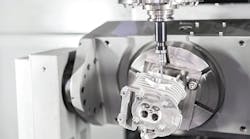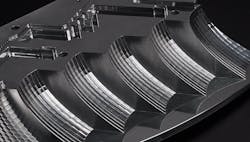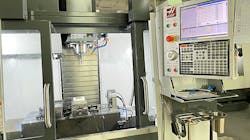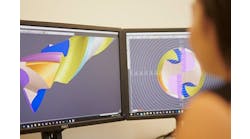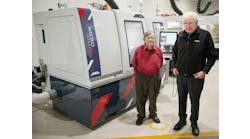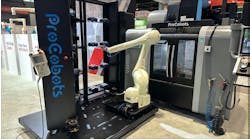Numerical control technology has a wide range of applications. Numerical control systems occupy a large proportion in the CNC machine tool control system.
Machining has high requirements on the accuracy and speed of processing, especially in the fields of aviation, aerospace and navigation, which require high-quality precision machined parts and also the dimensional accuracy and geometric accuracy of parts after processing.
Also read: Precision, accuracy and feed-rate needs dictate CNC machinery upgrades
The development and application of CNC technology in machine tools will affect the machining accuracy of CNC machine tools and can provide a powerful boost for industrial development (Figure 1).
Composition and characteristics of CNC technology
Numerical control technology is an organic combination of digital computer control technology and mechanical manufacturing technology. Its most typical representative is the numerical control machine tool. From the development of the first numerical control machine tool, numerical control technology has shown a leap forward. CNC machine tools integrate sensor technology, optoelectronic technology and computer and communication networking technology, so that CNC machine tools are more informatized and intelligent, not only for faster data processing speed and machine tool movement, but the cutting speed is faster and the machining accuracy of the CNC machine tool is higher and the machining speed is faster.
CNC machine tools occupy an important position in the development of modern industry. CNC technology is an integrated technology and a systematic project. It consists of multiple components working together to jointly promote the development of digital control technology.
Connection and application of group technology and CNC technology
Figure 2: The system formed by the combination of group technology and numerical control technology makes full use of the functions of each.
Group technology and CNC technology are complementary to each other. With group technology (GT), similar parts or processes are grouped together in one location to leverage those similarities by using fewer machines.
CNC technology’s deep connection and integration with the group technology has promoted manufacturing to a new stage. The flexible processing system formed mainly by numerical control technology and supplemented by group technology can efficiently process multiple varieties and small batch parts, occupying an important position in the field of modern machining. The industrial manufacturing system formed by the close combination of group technology and numerical control technology not only brings help to the processing and manufacturing industry, but also provides technical support for computer-aided design and computer-aided manufacturing technology, which is a concentrated expression of numerical control technology.
The deep combination of group technology and numerical control technology has not only greatly improved the machining form, accuracy and machining efficiency, but also has a great influence on the production organization form. The processing system formed by the combination of group technology and numerical control technology makes full use of the functions of each link through the reasonable allocation of various elements of mechanical production to improve the economic benefits of the enterprise (Figure 2).
Application of CNC technology in the field of mechanical manufacturing
CNC machine tool is a typical application of CNC technology in the field of machining and manufacturing. The CNC machine tool is mainly composed of the machine tool mechanical structure part, CNC system, control module, CNC, PLC and CNC motor, and it is supplemented by hydraulic pressure, compressed air and other parts.
Modern CNC machine tools require high precision, which puts forward higher requirements for the mechanical structure of CNC machine tools: higher dynamic and static stiffness of the machine tool. The high precision of CNC machine tools is based on the dynamic and static stiffness of the machine bed. The frequency conversion motor used in CNC machine tools has a linear motion. The CNC machine tool will have a strong impact on the bed during high-speed movement. Dynamic and static stiffness of the machine tool will help the machine tool reduce vibration.
Figure 3: With the development of computers, communications and automation technology and the application of numerical control technology, the degree of automation and intelligence are continuously deepening.
The movement of the CNC machine tool is the drive chain from the frequency conversion motor through the drive screw to the machine tool cutter. The higher friction and transmission clearance of any transmission pair in the drive chain will have a serious impact on the overall transmission accuracy of the CNC machine tool. The high precision of CNC machine tools is based on mechanical rigidity and traditional characteristics.
The high-speed movement of CNC machine tools requires high precision and wear resistance of the mechanical parts of the machine tools, which can withstand the rapid friction caused by the high-speed movement of the machine tool in a short time and the temperature rise of the material.
Continuous research and application of materials, processing techniques and technologies used in CNC machine tools are required.
The numerical control technology represented by numerical control machine tools is occupying an increasing proportion. At the same time, with the development of computers, communications and automation technology, and the application of numerical control technology, the degree of automation and intelligence are also continuously deepening (Figure 3).
This has laid a good foundation for the progress of the industrial system, formed by the combination of numerical control technology and traditional industry. It includes:
- flexible manufacturing system (FMS)
- computer integrated manufacturing system (CIMS)
- distributed numerical control (DNC) system
- STEP-NC system
- artificial intelligence.
FMS: The flexible manufacturing system is an organic combination of the logistics transportation system and the numerical control processing system. The biggest feature of this system is the ability to combine random automatic manufacturing with no fixed processing sequence and mechanical processing equipment. The use of a computer for centralized control allows the workpiece complete integrated processing and manufacturing.
The flexible manufacturing system can be applied in small and medium-sized processing enterprises. Not only is the application cost low and the scale is small, but also the application is more efficient and reliable. The flexible manufacturing unit is an important part of the flexible manufacturing system. The processed workpiece is fixed on the pallet, and the clamping of the workpiece is completed through the exchange of the pallet, thereby achieving seamless connection of the workpiece processing. The flexible manufacturing unit can play an efficient role in the processing of a single batch and a large batch of parts, so as to realize the efficient production of large batch.
CIMS: The computer integrated manufacturing system integrates modern management technology, manufacturing technology and information technology, and it utilizes the data-processing capabilities of the computer to achieve production for enterprises. The calculation, processing and deployment of technology, personnel and logistics information in the process enable efficient allocation and utilization of resources.
DNC: The distributed numerical control system adopts the one-to-many control mode, with one or more computers as the host computer of the entire system. The host can realize the inspection, control and information transmission of the controlled calculation. By applying it in the processing management of the enterprise, it can effectively reduce the intermediate link of the workpiece from programming to processing, and the process programmer can directly transfer to the required processing through the DNC system after completing the programming of the required processing parts. The machine tool operator combines the completed machining program to complete the processing and manufacturing of parts. The DNC system can connect multiple CNC machine tools in the processing workshop through a large CNC machining system and can obtain large-scale processing results.
STEP-NC: STEP-NC technology has the advantages of being able to process complicated information, realize intelligent control processing, visually display processing tasks and complete product information description when it is used.
The core advantage of STEP-NC technology is that the machining system can complete the design of the machining tool movement mode according to the designed workpiece drawings and realize the possibility of product manufacturing and processing according to the design drawings.
Figure 4: New technologies have brought both opportunities and challenges.
The core of the technology is to read the data of the design drawings. Therefore, in the research and application of the technology, it is necessary to strengthen the development of the file-reading technology to improve the reading efficiency and ensure the accuracy of the relevant data reading.
In the past, traditional STEP-NC technology, numerical control technology used an indirect rather than direct way to complete the reading and control of related data, but the traditional STEP-NC technology uses indirect interpretation technology. The low reading efficiency cannot maximize the advantages of STEP-NC technology. The direct interpretation and adaptive interpretation used by STEP-NC technology can effectively avoid the problems caused by the traditional STEP-NC technology indirect interpretation. Therefore, in the development and application of STEP-NC technology, it is necessary to strengthen the research on this technology and use new technologies to improve the application prospects of CNC technology, so as to make CNC technology get better development.
Artificial intelligence: We are an information society, and the Internet + technology represented by cloud computing, artificial intelligence and big data technology has combined with the numerical control technology to rejuvenate NC technology. Artificial intelligence and machine learning will provide more power for manufacturing. The "Smart Manufacturing 2025" strategy released by China is based on this core concept.
New technologies have brought both opportunities and challenges (Figure 4). CNC technology should actively explore the development and application of artificial intelligence, promote the deep integration of a new generation of artificial intelligence technology and CNC technology, and form a more intelligent CNC machining equipment, so as to indicate the direction of the development and application of CNC technology.
Raymond Cheng is rapid prototyping and rapid manufacturing expert, specializing in CNC machining, 3D printing, urethane casting, rapid tooling, injection molding, metal casting, sheet metal and extrusion at WayKen Rapid Manufacturing, which provides one-stop rapid prototyping services and low-volume manufacturing services, including CNC machining, 3D printing, vacuum casting, rapid tooling, and injection molding in ShenZhen, China. Contact him at [email protected].
Sponsored Recommendations

Leaders relevant to this article:
